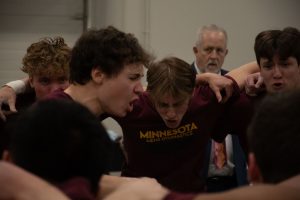In recent years, cuts to funding and changes to child care on campus have left two day care centers near the University of Minnesota struggling.
The centers, the Como Early Learning Center and Community Child Care Center, are located in University-owned cooperatives close to campus and primarily serve graduate and professional student parents.
While these co-op child care centers are not affiliated with the University, student parents involved with the centers can apply for Student Services Fees as a student group to fund the operational costs of the day cares.
“For student parents one of the biggest helps, especially for international student parents or any parents that don’t have a support network or family around, child care is critical,” said Fernando Severino, the chair of the CCCC student board and a student parent.
In 2016, the Student Services Fee (SSF) process changed, implementing a $55,000 cap on the amount of funds each student group can receive within the University, including the centers. Before the cap was put in place, the centers were each receiving around $90,000 a year for their overall budgets.
Additional limitations were put in place that limit how groups can spend the money they receive from the SSF. This funding is specifically designated for students who pay the SSF, not their dependents.
For the child care centers, some of these limitations prevented them from receiving funding for expenses like art supplies and food.
For example, the SSF committee did not allocate funds to the CCCC’s fall 2018 request for food because “the request described the benefits to the children who do not pay the Student Services Fee.”
Tracie Myers, director of the CCCC, said the limitations now mean the center can no longer use the funds from the SSF to pay teacher salaries. Myers said the CCCC will continue to apply for the SSF because they have found no other funds to cover the discounts it offers to students and other expenses.
“The part that’s so difficult for us is because we are in early childhood education … for us it’s difficult to find alternate forms of funding without making the students kind of take the full brunt of that,” Myers said. “Ultimately, we did have to increase the weekly fees that students pay for their kids to be here.”
When SSF funding was at its peak, the CELC was able to provide a 25 percent discount to student parents for childcare costs. As funds allocated to the centers have decreased, so have the discounts.
Because of the decrease in funding and the extensive, months-long process applicants must go through to receive funding through the SSF, the CELC ultimately decided this July to no longer apply for funds through the SSF. As a result, tuition rates for the daycare centers will no longer be discounted to students.
Rebecca Stabler is a mother of two and married to a University graduate student. She serves as the chair of the CELC. As both a board member and a parent, she has seen how challenges have mounted for the center as funds have dwindled.
“At some point the University cared, right?” Stabler said. “They’re slowly backing away.”
A committee of students decides how much SSF funding each group receives per semester. The process is “viewpoint neutral,” meaning the committee treats all student groups the same and does not prioritize any one issue, including child care.
“The funding wasn’t cut – the process was changed,” said Sara Carvell, associate director of the Office of Student Affairs. “Groups come and apply for this money every year, so it’s never guaranteed.”
The University knew the changes would affect the child care centers when the SSF process changed in 2016, so it created a $150,000 grant pool for all student parents and their child care costs, Carvell said.
After a 2018 announcement that the on-campus Child Development Center would close, protests prompted the formation of Provost’s Child Care Advisory Committee to look at child care needs on campus.
The 20-person child care committee had two student representatives and no representatives from either the CCCC or the CELC. In the 50-page report produced by the committee to highlight the importance of child care to the University, the centers were mentioned once. The University’s Child Development Center, which serves mostly University staff and faculty, was mentioned nearly 30 times.
“I’m always hopeful that [the University] will use us as a resource,” Executive Director of CELC Katie Johnson said. “My hope is that they will include us in discussions going forward about child care on campus in general … I would love to be part of that community.”
Going forward, Stabler is hoping to create more of a sense of community among student parents and increase student representation in making child care decisions.
“…If you’re looking at power structures, students don’t have the most power,” Stabler said. “One staff member at the University said, ‘We know that we have the power, we aren’t gonna let you guys fall behind’ — and they let us fall.”
Michelle Griffith contributed to this story.
Correction: A previous version of this article misstated the acronym for the Como Early Learning Center.















